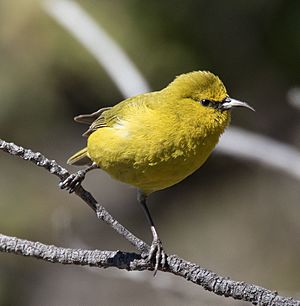Hawaiʻi ʻamakihi facts for kids
Quick facts for kids Hawaiʻi ʻamakihi |
|
|---|---|
 |
|
| Hawaiʻi ʻamakihi on Hawaii | |
| Conservation status | |
| Scientific classification | |
| Genus: |
Chlorodrepanis
|
| Species: |
virens
|
| Synonyms | |
|
Hemignathus virens |
|
The Hawaiʻi ʻamakihi (Chlorodrepanis virens) is a small, bright yellow-green bird. It is also known as the common ʻamakihi. This bird is a type of Hawaiian honeycreeper, which are special birds found only in Hawaii.
Contents
About the Hawaiʻi ʻamakihi
What's in a Name?
Scientists group living things to understand them better. This is called taxonomy. The Hawaiʻi ʻamakihi used to be in a group called Hemignathus. But after looking closely at its DNA, scientists moved it to a different group, Chlorodrepanis. This new group helps us see how it's related to other birds.
Different Types of Amakihi
There are two main types, or subspecies, of the Hawaiʻi ʻamakihi.
- C. v. wilsoni: This type lives on Maui and Molokaʻi. It used to live on Lānaʻi too, but it's not seen there anymore.
- C. v. virens: This type lives on the Big Island of Hawaiʻi.
What Does the Amakihi Look Like?
The Hawaiʻi ʻamakihi is a small bird, about 10 centimetres (3.9 in) long. That's about the length of your palm! It has yellow-green feathers. Its small black bill is about 1.3 centimetres (0.51 in) long. The bird has brown eyes with black centers.
Amakihi Song
The main song of the Hawaiʻi ʻamakihi is a fast, chirping sound called a trill.
What Do Amakihi Eat?
The Hawaiʻi ʻamakihi eats many different things. This helps it find food even when its home changes. It has a special tube-shaped tongue. It uses this tongue to drink nectar from flowers. Some of its favorite flowers are the ʻōhiʻa lehua, ʻākala, and māmane. If there are no flowers, it can also suck juice from fruits. The Hawaiʻi ʻamakihi also hunts for spiders and insects among trees and bushes.
Amakihi Life Cycle
Reproduction and Chicks
Hawaiʻi ʻamakihi are good at having babies. They have a long breeding season that lasts about 9 months. On the Big Island, Maui, and Molokaʻi, the breeding season can start at different times. It often begins when māmane trees are flowering in dry forests.
These birds build their nests high up in the tops of trees. They can often have two groups of chicks in one breeding season. Having two rounds of babies helps their population grow faster. This is different from slower-growing birds like the endangered Kiwikiu.
Baby Hawaiʻi ʻamakihi stay in their nest for 15 to 21 days. After that, they are ready to fly. Young ʻamakihi become independent from their parents when they are 2 to 3 months old.
Where Do Amakihi Live?
The Hawaiʻi ʻamakihi lives on the Big Island, Maui, and Molokaʻi in Hawaii. It used to live on Lānaʻi, but it was last seen there in 1976.
This bird is one of the most common Hawaiian honeycreepers. It lives in many different places, from dry māmane forests to wet forests. You can find them from sea level up to 8,000 feet (2,400 m) high. On Maui, they even do well in forests with pine, cypress, and fir trees that were brought there by people.
Of all the native Hawaiian forest birds, the Hawaiʻi ʻamakihi has been least affected by changes to its habitat. Scientists think it might be developing ways to fight diseases like avian malaria. The Hawaiʻi ʻamakihi is listed by the IUCN as a species of least concern. This means it is not currently in danger of disappearing.
See also
 In Spanish: Amakihi de Hawái para niños
In Spanish: Amakihi de Hawái para niños



